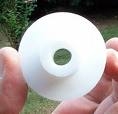- BY Admin
- POSTED IN Articles
- WITH 0 COMMENTS
- PERMALINK
- STANDARD POST TYPE

In chemistry, polytetrafluoroethylene (PTFE) is a synthetic fluoropolymer of tetrafluoroethylene which finds numerous applications. PTFE is most well known by the DuPont brand name Teflon.
PTFE is a fluorocarbon solid, as it is a high molecular weight compound consisting wholly of carbon and fluorine. Neither water and water-containing substances nor oil and oil-containing substances are wet by PTFE, as fluorocarbons demonstrate mitigated London dispersion forces due to the high electronegativity of fluorine.
PTFE is used as a non-stick coating for pans and other cookware. It is very non-reactive, partly because of the strength of carbon–fluorine bonds, and so it is often used in containers and pipework for reactive and corrosive chemicals. Where used as a lubricant, PTFE reduces friction, wear and energy consumption of machinery.
History
PTFE was accidentally invented by Roy Plunkett of Kinetic Chemicals in 1938. While Plunkett was attempting to make a new CFC refrigerant, the perfluorethylene polymerized in its pressurized storage container, with the iron from the inside of the container acting as a catalyst. Kinetic Chemicals patented it in 1941 and registered the Teflon trademark in 1945.
By 1950, DuPont had acquired interest in Kinetic Chemicals and was producing over a million pounds (450 tons) of Teflon per year in Parkersburg, West Virginia. In 1954, French engineer Marc Grégoire created the first pan coated with Teflon non-stick resin under the brandname of Tefal after his wife urged him to try the material he had been using on fishing tackle on her cooking pans. In the United States, Kansas City, Missouri resident Marion A. Trozzolo, who had been using the substance on scientific utensils, marketed the first frying pan, “The Happy Pan,” in 1961.
An early advanced use was in the Manhattan Project as a material to coat valves and seals in the pipes holding highly reactive uranium hexafluoride in the vast uranium enrichment plant at Oak Ridge, Tennessee, when it was known as K-25.




